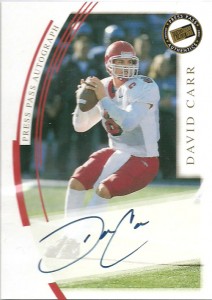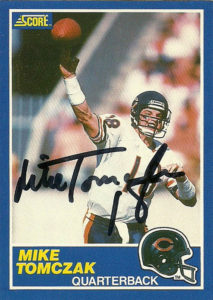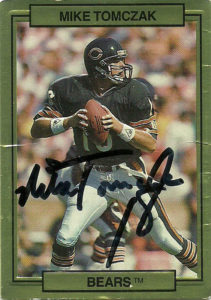
Card: PressPass 2002
Acquired: Purchase 2010, Beckett.com
In an attempt to catch up on the Texans, I purchased all of their first round draft choices certified autographs through Beckett.com. While I shrug typically at the practice of doing so because it lacks the element of the memory or the hunt, it does help me put my memories of the team in perspective- some 9 seasons after they became a franchise.
I remember when the draft came that season. I was living high on the hog as a stockbroker and the Texans had the #1 card simply because they were an expansion team in 2002. As the draft approached two names surfaced- David Carr and Drew Henson. Henson opted to play for the Yankees and bowed out practically leaving Carr as the defacto #1 quarterback in the draft after he had an outstanding career at Fresno State. When the name surfaced, I literally said, “Who?” Looking back now at this draft- it was just disastrous on the offensive side of the ball. Only one quarterback out of this draft- David Garrard, has made the ProBowl (and that is because everybody else bowed out in 2009). In the end, Clinton Portis would be the biggest name to come out of the offensive side of the draft.
Here’s the thing and retrospect is a bitch, the Texans should’ve been looking elsewhere than quarterback. Just because you draft #1 doesn’t mean you get the best player at any position and then you have to weigh in the talent as far as how they’d compete against the rest of the league. It’s just this- you can be the best at your position, but still be not that good when you get on the big stage, because the player position you came in with wasn’t that great.
I have a lot of empathy for David Carr. He had to shoulder the burden of being the Texans franchise #1 overall pick. Playing for an expansion team, for a city that was ‘quality’ football playoff starved can put a lot of pressure on a young guy. Carr was likable enough, with good moral character and was quite trainable. The problem was he was picked apart and scouts didn’t like the mechanics of his throwing arm or his questionable arm strength. Furthermore being quite trainable can be a double-edged sword because you can be trained to do really bad things.
Well the Texans first game started out great. David Carr and the team silenced all critics stunning the league with a 19-10 victory over their cross-state rival Dallas Cowboys. It was only the second time in NFL history an expansion team came out of the gates with a victory. After that it wasn’t so great as the team skidded to a 4-12 record. The greatest problem was a twofold issue. Carr was sacked way too much because of a pourous offensive line, (setting an NFL record with an astounding 72 sacks), and he was holding onto the ball way too long. His stats weren’t great and he was expected to improve. While 2003 was a marginal improvement Carr would be injured starting only 12 games that season. In 2004 Carr finally started turning the corner, setting career highs in all passing categories and had a respectable 83.5 quarterback rating working with young wide receiver Andre Johnson. The team went 7-9 and hopes were high. The sacks problem though re-emerged and Carr went down 49 times. At some point the coaching staff decided the problem wasn’t the offensive line- rather it was David Carr’s awareness, and in a Pavlovian like move they installed a buzzer in practice that would sound to remind Carr that he needed to throw the ball if he held it longer than 4 seconds. This probably made Carr more skittish and was only putting a band-aid over the Texans’ gaping wound- the offensive line, as in 2005 David suffered the wrath of 68 more sacks. (I really questioned this because Carr was an avid scrambler who put up some 1100 yards rushing in his career in Houston.) The team regressed to a 2-14 record and the complete staff was fired from Houston. With the arrival of new coach Gary Kubiak and general manager Rick Smith, the Texans were again at the helm of the draft in 2006. The consensus was that the Texans would take Reggie Bush or maybe even hometown hero quarterback Vince Young. The Texans did neither, placing their confidence in David Carr for an additional season and drafted Mario Williams, but Kubiak let Carr know he was on a short leash. Carr’s final season in Houston would be something on TV full of effort but error prone and after 5 seasons, the writing was on the wall that Carr was no longer the franchise’s quarterback as his work ethic then became a source of scrutiny. With a trade to Atlanta the Texans grabbed Matt Schaub and Carr was asked to take a salary cut to play backup. Balking at the move, the Texans outright cut Carr from the team. His tenure in Houston was over.
Carr would become a journeyman, playing for the Carolina Panthers in 2007 and the Giants in 2008 and 2009. In 2010 he signed with the 49ers where he was the only quarterback under contract after the dismissal of Mike Singletary and his staff, and the hiring of Jim Harbaugh. During the 2011 offseason the 9ers would let him walk and he’d re-sign with the Giants.
Carr’s career since Houston has been largely in mop up duty and fairly ignorable. Despite his impressive 2009 spot work (behind encumbent Eli Manning) in New York, it remains to be seen what the future holds for David Carr. I do sometimes wonder how David’s career would have turned out if he wasn’t under the microscope in Houston and I hope for the best for him. When I see the worst picks of all time, I fret when Carr is considered a ‘bust’, because what choice did he or this franchise have?
Of note, Carr has a penchant of wearing a glove on one hand to help him grip the ball better in cold weather, on the advisement of former quarterback Jim McMahon. It’s undetermined whether or not this actually benefitted David, as he fumbled 21 times in 2002, 17 times in 2005 and 16 in 2006. That means during roughly some 2500 snaps Carr has fumbled once in every 27 times he touched the ball. During the team’s 7-9 run Carr had a bet that as long as the Texans couldn’t win two games in a row he’d keep growing his hair longer and was named one of ‘People’s Sexiest Men Alive’ that year. His number has also since been retired by his college, Fresno State.
G/Gs 92/79 Att 2264 Comp 1351 Yds 14433 Pct 59.7 Td 65 Int 71 Rat 74.9
Rush 302 Yds 1331 Avg 4.4 Td 9


 Tomczak had some great cards over his career. It took me some time to figure out which ones to send him. After some deliberation I decided on these three. I liked the design and photo for all three of these cards. Action Packed did a short run test promo in 1989 that covered a few NFC teams. It was pretty much identical to their 1990 run, minus the copyright. Score 1989 was blockbuster by any right with the vibrant colors and strong action photos standing out. Skybox was a late addition to the market, coming from the basketball arena, but its initial offering was simple, clean, and impressive.
Tomczak had some great cards over his career. It took me some time to figure out which ones to send him. After some deliberation I decided on these three. I liked the design and photo for all three of these cards. Action Packed did a short run test promo in 1989 that covered a few NFC teams. It was pretty much identical to their 1990 run, minus the copyright. Score 1989 was blockbuster by any right with the vibrant colors and strong action photos standing out. Skybox was a late addition to the market, coming from the basketball arena, but its initial offering was simple, clean, and impressive.
